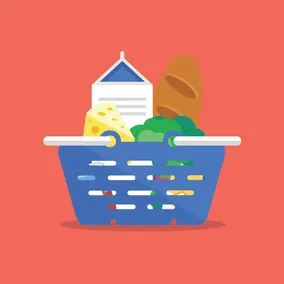Why Has a Trip to the Grocery Gone Largely Unchanged in 65 Years?

Jason Toth, Former Experience Design Director
Article Category:
Posted on
Over the past few decades, the grocery shopping experience hasn't fundamentally improved. Why?
Growing up, I can vividly recall our family’s weekly excursion to the local grocery chain. Our food list in hand, kids in tow, and coupons in pocket, we trekked through the grocery store on a quest to conquer what always seemed impossible: getting the week’s food in under an hour. My mother, always the stalwart leader, doled out captivating tasks to keep us amused. We fetched her items, and consequently, tried to sneak junk food into the cart from our mini-tasks. She maintained her role as the cart gatekeeper, blocking contamination from entering the basket.
However, if all went well and we were relatively behaved, a small reward awaited us on the last aisle of each weekly journey—a choice of confection from the baker’s counter to all helpful and well-behaved children. We endured the other fifty-eight minutes of choring for that one sweet moment of victory.
Mix in some moments of whining, some laughs over how food looks, and some negotiations over the planned meals for the week, and this was the overall grocery experience as a kid. This was the game, and this is how we played.

Considering the modern grocery store, our in-store experience is more or less the same. Grocery lists and coupons are still an integral part of the visit (accessed via a litany of grocer apps), and we still dole out cookies to well-behaved children. You still stand in a checkout line and scan your products, although now you can use your phone to make a payment. Depending on where you live, you might order your groceries online. Some grocers are even introducing virtual grocery shelves, robots, digitized pricing strips, and smart carts.
These latter innovations are trying to address deficiencies or improve efficiencies, yet they are still relatively tangential and undifferentiated moments within the overall experience. But even then, in terms of pure efficacy, some of the most requested features like scanless bagging and product location services are unavailable.
These trends show that most technological affordances center on expediency or convenience—avoiding lines, faster checkouts, reusing grocery lists, or more pronounced promotional awareness. Yet apart from some of the exceptions listed above, these technologies have not fundamentally altered, challenged, or elevated the basic shopping experience. Made it more convenient? Sure. Made it more educational? More personal? More delightful? Not really.
Some grocers have tried to introduce non-efficacy related experiences like educational events, cooking demonstrations, or even in-store meal preparation, but these often feel external or decoupled from most shoppers’ routine shopping needs. You have to make plans to attend these as they aren’t integrated into everyday shopping.
This is the biggest challenge grocers face: a need to differentiate in a competitive marketplace when investment in online grocery services hasn’t paid off. Why hasn’t it? Research indicates that people are still reasonably content with the current grocery shopping operation. But what if grocers shifted their focus? How can we use technology to enhance, improve, and make the in-store shopping experience more rewarding?
What if that experience became even more personalized? What if the value of digital services grocers provided in-store were the reason shoppers chose their store? What if grocery stores reimagined themselves as a major public health champion and a primary source of education on food and nutrition? What if the grocery store could help shape a new generation of children who didn’t see the grocery store as a disruption of their play time, but as an exciting, playful experience in and of itself?